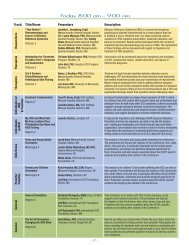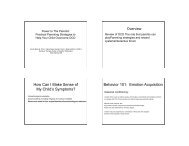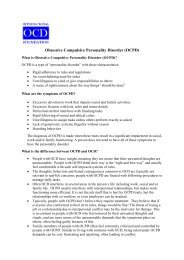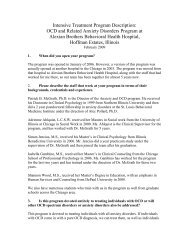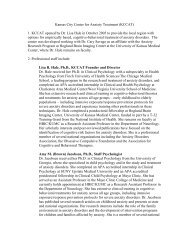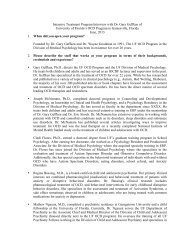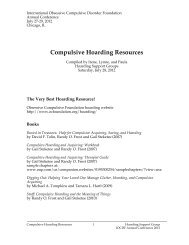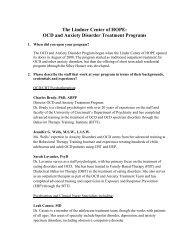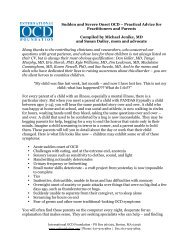Sage Anxiety Treatment Program
Sage Anxiety Treatment Program
Sage Anxiety Treatment Program
Create successful ePaper yourself
Turn your PDF publications into a flip-book with our unique Google optimized e-Paper software.
Intensive <strong>Treatment</strong> <strong>Program</strong> Description<br />
<strong>Sage</strong> <strong>Anxiety</strong> <strong>Treatment</strong> <strong>Program</strong><br />
1. When did you open your program<br />
The Intensive <strong>Treatment</strong> <strong>Program</strong> opened on October 24, 2011<br />
2. Please describe the staff that work at your program in terms of their backgrounds,<br />
credentials and experience<br />
Robin Taylor Kirk, LMFT, Director: 7 years of experience treating OCD, 18 years of<br />
experience treating anxiety disorders and eating disorders; an IOCDF BTTI Graduate;<br />
presenter at three of the past four IOCDF conferences; presenter for the Sacramento Affiliate<br />
Chapter of IOCDF; Instructor at JFK University on the topics of anxiety disorders and mood<br />
disorders; presenter at MFT and LCSW professional organization meetings and frequent<br />
presenter to community groups; provider of information to media sources; former co-owner<br />
of residential and intensive outpatient program for eating disorders.<br />
Melanie Mopsick, LCSW, psychotherapist: 20 years of experience treating anxiety disorders;<br />
attendance at many trainings including a day long training on OCD spectrum disorders<br />
Janet Spaulding, LMFT: Janet has been licensed for ten years and joined <strong>Sage</strong> 3 months ago;<br />
attended three month three hour per week training on OCD spectrum disorders<br />
Julie Jorgenson, MFTI: 1 year experience treating OCD; attended twelve month three hour<br />
per week training on OCD spectrum disorders<br />
Deborah Miller-Froh, MFTI: 1 year experience treating OCD; attended twelve month three<br />
hour per week training on OCD spectrum disorders<br />
Fiona Arenson, MFTI: 3 months experience treating OCD; attended three month three hour<br />
per week training on OCD<br />
3. Is this program devoted entirely to treating individuals with OCD or will other OCD<br />
spectrum disorders or anxiety disorders also be addressed<br />
OCD, other anxiety disorders, hypochondriasis, body dysmorphic disorder, hoarding,<br />
trichotillomania and dermatillomania are addressed in the <strong>Sage</strong> Intensive Outpatient<br />
<strong>Program</strong>.
4. Please describe the core treatment components of your program (e.g., use of<br />
medication, ERP, group therapy, etc.).<br />
The core treatment components used at <strong>Sage</strong> include ERP, Acceptance and Commitment<br />
Therapy, individual therapy, group therapy and a weekly Family Support group which<br />
includes psycho-education. <strong>Sage</strong> does not have a psychiatrist on-site; we work with several<br />
psychiatrists in the area and are happy to provide referrals and coordination of care.<br />
5. Please describe the treatment planning process at your program.<br />
While treatment discussions are held spontaneously as needed, treatment planning is formally<br />
scheduled for two hours on Monday, 30 minutes on Wednesday and 30 minutes on Thursday.<br />
These meetings are attended by all clinical staff and during this time information about<br />
clients scheduled to begin the program is presented, the work/progress/challenges of each<br />
client during the previous week or day of service is discussed and further treatment is<br />
planned. Progress and areas of focus are based not only on participation in exposures, but<br />
also on the six core processes of Acceptance and Commitment Therapy (i.e. present moment<br />
awareness, self-as-context, values, committed action, acceptance and defusion). Exposure<br />
records are examined to identify areas of additional focus for each client.<br />
6. If someone has a co-morbid condition, can he or she participate in your program Will<br />
there be treatment for the co-morbid condition If so, can you give an example<br />
Yes, individuals with co-morbid conditions may participate in the program. <strong>Sage</strong> includes<br />
one fifty minute individual therapy session each week. Clients are assigned an individual<br />
therapist when beginning the program and continue to see that clinician for individual<br />
sessions throughout the program. We also offer the flexibility to include more individual<br />
sessions and/or family/couple sessions if the need arises. <strong>Treatment</strong> for the co-morbid<br />
condition is included in the intensive program. One example is the treatment of eating<br />
disorders. Robin Kirk, LMFT has 17 years of experience treating eating disorders and is the<br />
former co-owner of Summit Intensive Outpatient <strong>Program</strong> for eating disorders. If a client<br />
presents to <strong>Sage</strong> with an eating disorder which is medically stable and appropriate for<br />
treatment at the outpatient level of care, treatment is provided in individual sessions. The comorbidity<br />
of eating disorders and anxiety disorders is high and the ACT concepts are very<br />
useful in the treatment of both disorders. We also have a clinician on staff specializing in the<br />
treatment of Bereavement.<br />
7. Are parents, family members, friends, teachers, etc. included in the treatment If yes,<br />
please describe how.<br />
Yes, parents, family members and friends are included in treatment in that they attend a<br />
weekly Family Support Group during which they receive psycho-education and coaching<br />
with respect to anxiety disorders and how to best help their loved ones. Family therapy is
also available. The cessation of reassurance-giving and performing behaviors for loved ones<br />
(e.g. opening the door for someone with contamination OCD) is challenging and we have<br />
found that ongoing education, support and problem-solving contributes significantly to<br />
clients’ progress. Family members and friends are also invited to continue in the Family<br />
Support Group after their loved one steps down from the Intensive Outpatient <strong>Program</strong> to<br />
individual therapy. The individual clinician working with a particular client is the liaison<br />
with the client’s teachers, other/former individual outpatient therapists, primary care<br />
physicians and psychiatrists. Each relevant collateral person is contacted at the beginning of<br />
and throughout treatment.<br />
8. How often do patients in the program meet with staff individually How long are these<br />
individual sessions<br />
Each client has an individual therapist with whom he or she meets weekly for a fifty minute<br />
psychotherapy session. This schedule may be adjusted to include more frequent individual<br />
sessions if the need arises. The client also works with this therapist to plan exposures.<br />
9. Is there a set time period for a patient’s treatment in the program What is the overall<br />
time commitment to the program (for example, attend daily for three weeks) How<br />
much flexibility is there in extending someone’s stay if needed<br />
Clients usually attend the program between three and five days per week, depending on need,<br />
for three hours per day. The program consists of both individual and group therapy. The<br />
minimum length of stay at <strong>Sage</strong> is four weeks. The first two weeks of the program are<br />
largely devoted to the concepts of Exposure and Response Prevention and Acceptance and<br />
Commitment Therapy. This provides each client with a solid foundation from which to<br />
begin exposure in earnest in week three of the program. Exposure homework is assigned for<br />
those days on which the client does not attend the program. If needed, clients may attend<br />
five days of service per week. There is significant flexibility in extending clients’ stay. <strong>Sage</strong><br />
is in-network with several insurance carriers and obtains single-case-agreements if not innetwork.<br />
Our philosophy is that clients are welcome and encouraged to stay as long as<br />
necessary before stepping down to individual therapy. We work diligently with insurance<br />
companies to obtain the necessary authorizations and to demonstrate medical necessity for<br />
extended stays. For individuals who private pay, we provide long-term financing and also<br />
accept credit cards. <strong>Sage</strong> generally provides two pro bono courses of treatment per year. It<br />
is our commitment to provide care as long as this level of care is therapeutically indicated.<br />
10. Is there a homework or “self directed” component to the treatment<br />
There is a homework component to the program. Clients receive instruction in mindfulness<br />
meditation which they practice not only in the program, but also at home. In addition, once<br />
exposures are begun in the program, clients are expected to do at least one hour per day of<br />
exposure on the days they do not attend the intensive program. While this formal homework
is decided upon collaboratively between clinical staff and the client, it is usually reported by<br />
clients that they also encounter many in vivo exposure opportunities during the course of<br />
their day and having a solid foundation in the concepts of Acceptance and Commitment<br />
Therapy makes these “life happens” exposure opportunities much easier to approach. Not<br />
only does this provide additional ERP work, it also provides clients with a sense of agency<br />
that they are able to do the things that are important to them even if they are experiencing<br />
anxiety.<br />
11. Please describe the relapse prevention strategies you use in your program.<br />
As mentioned above, clients receive training in both ERP and Acceptance and Commitment<br />
Therapy. Once they have mastered the process, clients report confidence in being able to<br />
work with any trigger that comes along. In a more formal sense, upcoming possible stressors<br />
including decreasing the amount of treatment as well as life events that might result in<br />
relapse are identified and problem-solved. Clients are discharged to individual therapy with<br />
either the therapist they were seeing during the <strong>Sage</strong> program, or to the referring individual<br />
therapist. We coordinate with other clinicians to ensure they understand the ERP/ACT<br />
process and are available to answer questions even after a client has left the <strong>Sage</strong> program.<br />
Additionally, clients may attend a weekly support group with others who have completed the<br />
intensive program and their family members/friends may continue to attend the weekly<br />
Family Support Group.<br />
12. What kind of follow-up do you do for those who complete your program Will the<br />
members or your treatment team be in contact with or willing to consult with the<br />
individual’s regular treatment provider(s)<br />
With respect to clients who have completed the program, <strong>Sage</strong> does follow-ups on a three<br />
month, six month, one year and two year basis. The therapist with whom the client saw for<br />
individual therapy during the intensive program consults with the individual’s regular<br />
treatment provider prior to the commencement of the intensive program, during the program<br />
and is available for consultation once the client has completed <strong>Sage</strong>’s program.<br />
13. Do you offer a sliding fee scale or scholarships for those who cannot afford your<br />
program<br />
<strong>Sage</strong> offers a sliding scale for those who do not have insurance and also accepts major credit<br />
cards. We also offer payment plans that may extend beyond attendance in the program if that<br />
makes treatment more accessible. In addition, <strong>Sage</strong> generally offers two pro bono courses of<br />
treatment per year.<br />
14. Does your program only work with individuals who are local or are there arrangements<br />
for those who come from farther away (for example, lodging arrangements)
<strong>Sage</strong> is very conveniently located for those who come from out of the area. There is a long<br />
term stay hotel, grocery store, drug store, restaurants and other conveniences within a half<br />
mile of <strong>Sage</strong>. Our Intake Coordinator is happy to assist people who need to make<br />
arrangements for lodging while attending the program. We are also located on the American<br />
River which has a more than 25 mile bike/walking trail and many opportunities for<br />
recreation.<br />
15. Please add any information you think would be helpful in describing the unique aspects<br />
of your program if this has not been covered in the questions above.<br />
Our facility is uniquely designed for exposures and has a fully functional kitchen, two large<br />
group rooms, a “getting ready room” with a mirror and sink, multiple listening devices,<br />
TV’s/computers with internet and access to an onsite gym and locker room. There is ample<br />
space for nine clients to do exposures in private. Other features of the Intensive Outpatient<br />
<strong>Program</strong> at <strong>Sage</strong> include the assignment of each client to an individual therapist with whom<br />
the client has a weekly individual therapy session, the Family Support Group, the<br />
combination of Acceptance and Commitment Therapy with Exposure and Response<br />
Prevention which gives clients a different way to experience and relate to their anxiety and<br />
makes exposures easier to approach and a weekly process group for clients to help process<br />
the feelings associated with OCD Spectrum Disorders as well providing additional<br />
exposure/support for those with social anxiety.





